Advertisement and Its Use: A Comparative Analysis of Subway's Campaign
VerifiedAdded on 2022/10/01
|10
|2331
|302
Report
AI Summary
This report provides a comprehensive analysis of Subway's advertising campaign, examining its use of broadcast, print, and interactive media. The study begins with an introduction outlining the objectives of advertising, specifically increasing sales through persuasive techniques. The discussion section delves into the effectiveness of Subway's advertisements across different media platforms, including television commercials, print advertisements in newspapers and magazines, and interactive media strategies like social media campaigns. The report analyzes the creative concepts, media plans, advantages, and disadvantages of each medium, highlighting how Subway targets different consumer groups and leverages social responsibility themes. The conclusion summarizes the effectiveness of Subway's advertising campaigns and the importance of adapting persuasive language and creative techniques to connect with the target audience. References to academic sources are also included.
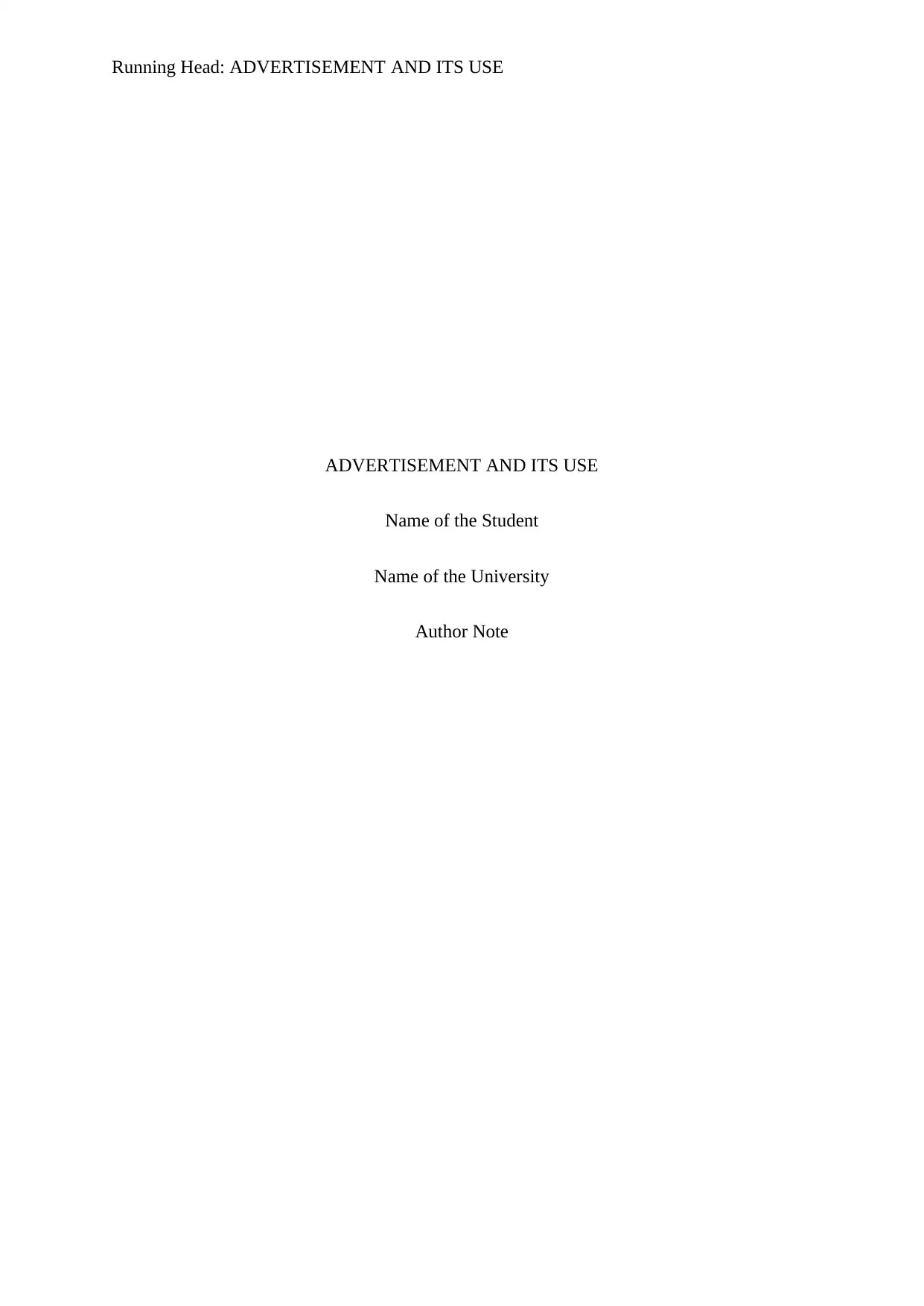
Running Head: ADVERTISEMENT AND ITS USE
ADVERTISEMENT AND ITS USE
Name of the Student
Name of the University
Author Note
ADVERTISEMENT AND ITS USE
Name of the Student
Name of the University
Author Note
Paraphrase This Document
Need a fresh take? Get an instant paraphrase of this document with our AI Paraphraser
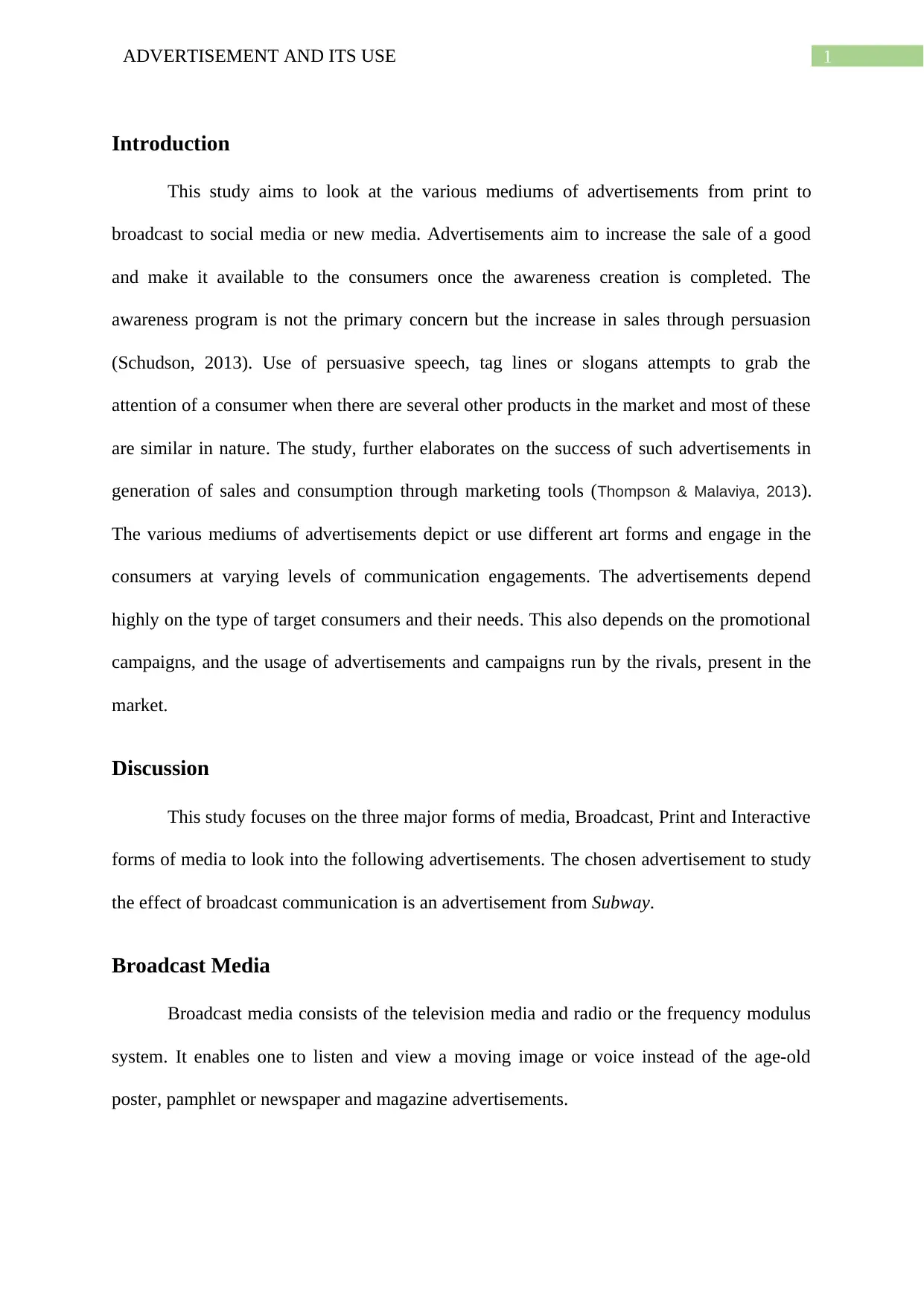
1ADVERTISEMENT AND ITS USE
Introduction
This study aims to look at the various mediums of advertisements from print to
broadcast to social media or new media. Advertisements aim to increase the sale of a good
and make it available to the consumers once the awareness creation is completed. The
awareness program is not the primary concern but the increase in sales through persuasion
(Schudson, 2013). Use of persuasive speech, tag lines or slogans attempts to grab the
attention of a consumer when there are several other products in the market and most of these
are similar in nature. The study, further elaborates on the success of such advertisements in
generation of sales and consumption through marketing tools (Thompson & Malaviya, 2013).
The various mediums of advertisements depict or use different art forms and engage in the
consumers at varying levels of communication engagements. The advertisements depend
highly on the type of target consumers and their needs. This also depends on the promotional
campaigns, and the usage of advertisements and campaigns run by the rivals, present in the
market.
Discussion
This study focuses on the three major forms of media, Broadcast, Print and Interactive
forms of media to look into the following advertisements. The chosen advertisement to study
the effect of broadcast communication is an advertisement from Subway.
Broadcast Media
Broadcast media consists of the television media and radio or the frequency modulus
system. It enables one to listen and view a moving image or voice instead of the age-old
poster, pamphlet or newspaper and magazine advertisements.
Introduction
This study aims to look at the various mediums of advertisements from print to
broadcast to social media or new media. Advertisements aim to increase the sale of a good
and make it available to the consumers once the awareness creation is completed. The
awareness program is not the primary concern but the increase in sales through persuasion
(Schudson, 2013). Use of persuasive speech, tag lines or slogans attempts to grab the
attention of a consumer when there are several other products in the market and most of these
are similar in nature. The study, further elaborates on the success of such advertisements in
generation of sales and consumption through marketing tools (Thompson & Malaviya, 2013).
The various mediums of advertisements depict or use different art forms and engage in the
consumers at varying levels of communication engagements. The advertisements depend
highly on the type of target consumers and their needs. This also depends on the promotional
campaigns, and the usage of advertisements and campaigns run by the rivals, present in the
market.
Discussion
This study focuses on the three major forms of media, Broadcast, Print and Interactive
forms of media to look into the following advertisements. The chosen advertisement to study
the effect of broadcast communication is an advertisement from Subway.
Broadcast Media
Broadcast media consists of the television media and radio or the frequency modulus
system. It enables one to listen and view a moving image or voice instead of the age-old
poster, pamphlet or newspaper and magazine advertisements.
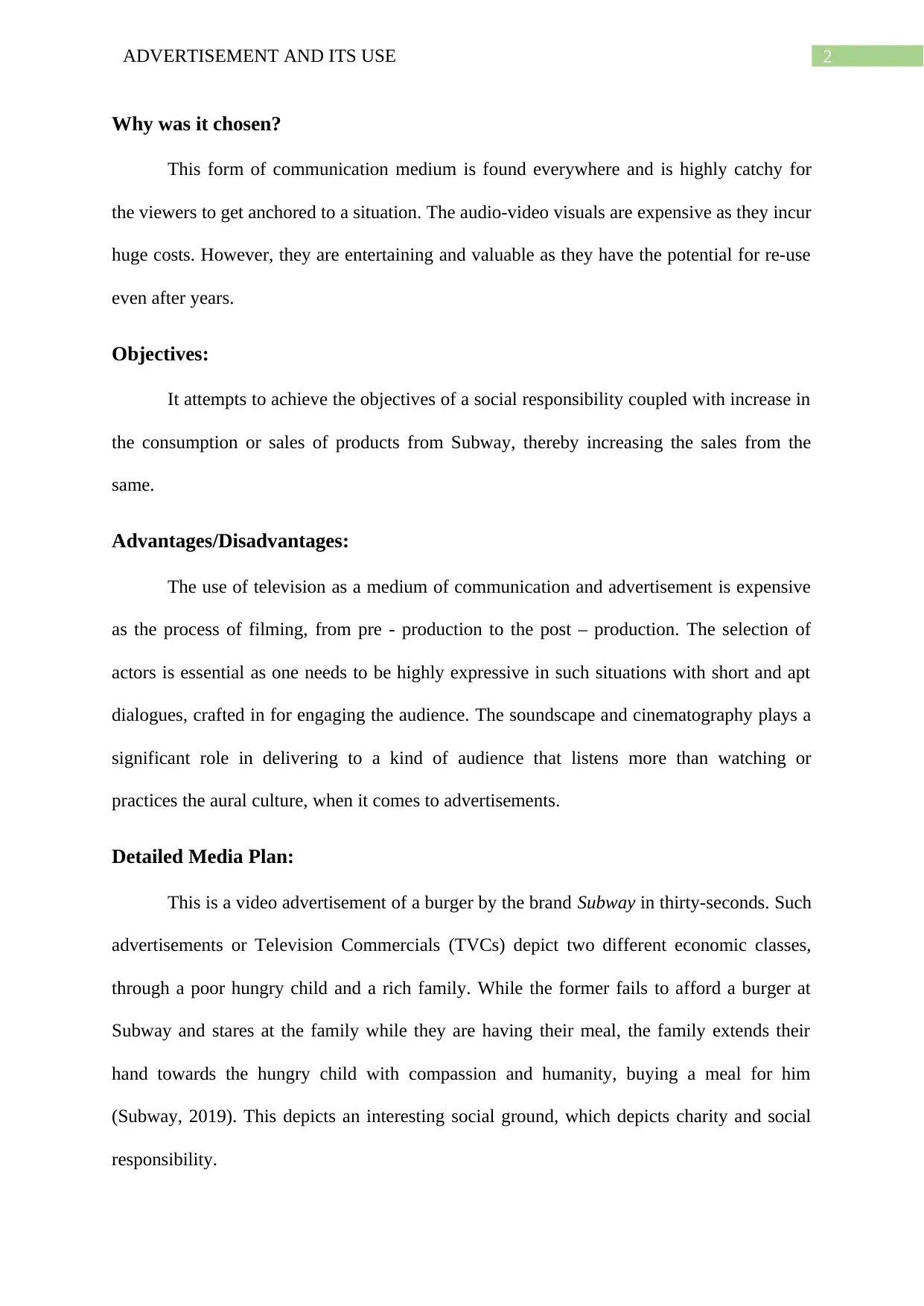
2ADVERTISEMENT AND ITS USE
Why was it chosen?
This form of communication medium is found everywhere and is highly catchy for
the viewers to get anchored to a situation. The audio-video visuals are expensive as they incur
huge costs. However, they are entertaining and valuable as they have the potential for re-use
even after years.
Objectives:
It attempts to achieve the objectives of a social responsibility coupled with increase in
the consumption or sales of products from Subway, thereby increasing the sales from the
same.
Advantages/Disadvantages:
The use of television as a medium of communication and advertisement is expensive
as the process of filming, from pre - production to the post – production. The selection of
actors is essential as one needs to be highly expressive in such situations with short and apt
dialogues, crafted in for engaging the audience. The soundscape and cinematography plays a
significant role in delivering to a kind of audience that listens more than watching or
practices the aural culture, when it comes to advertisements.
Detailed Media Plan:
This is a video advertisement of a burger by the brand Subway in thirty-seconds. Such
advertisements or Television Commercials (TVCs) depict two different economic classes,
through a poor hungry child and a rich family. While the former fails to afford a burger at
Subway and stares at the family while they are having their meal, the family extends their
hand towards the hungry child with compassion and humanity, buying a meal for him
(Subway, 2019). This depicts an interesting social ground, which depicts charity and social
responsibility.
Why was it chosen?
This form of communication medium is found everywhere and is highly catchy for
the viewers to get anchored to a situation. The audio-video visuals are expensive as they incur
huge costs. However, they are entertaining and valuable as they have the potential for re-use
even after years.
Objectives:
It attempts to achieve the objectives of a social responsibility coupled with increase in
the consumption or sales of products from Subway, thereby increasing the sales from the
same.
Advantages/Disadvantages:
The use of television as a medium of communication and advertisement is expensive
as the process of filming, from pre - production to the post – production. The selection of
actors is essential as one needs to be highly expressive in such situations with short and apt
dialogues, crafted in for engaging the audience. The soundscape and cinematography plays a
significant role in delivering to a kind of audience that listens more than watching or
practices the aural culture, when it comes to advertisements.
Detailed Media Plan:
This is a video advertisement of a burger by the brand Subway in thirty-seconds. Such
advertisements or Television Commercials (TVCs) depict two different economic classes,
through a poor hungry child and a rich family. While the former fails to afford a burger at
Subway and stares at the family while they are having their meal, the family extends their
hand towards the hungry child with compassion and humanity, buying a meal for him
(Subway, 2019). This depicts an interesting social ground, which depicts charity and social
responsibility.
⊘ This is a preview!⊘
Do you want full access?
Subscribe today to unlock all pages.

Trusted by 1+ million students worldwide
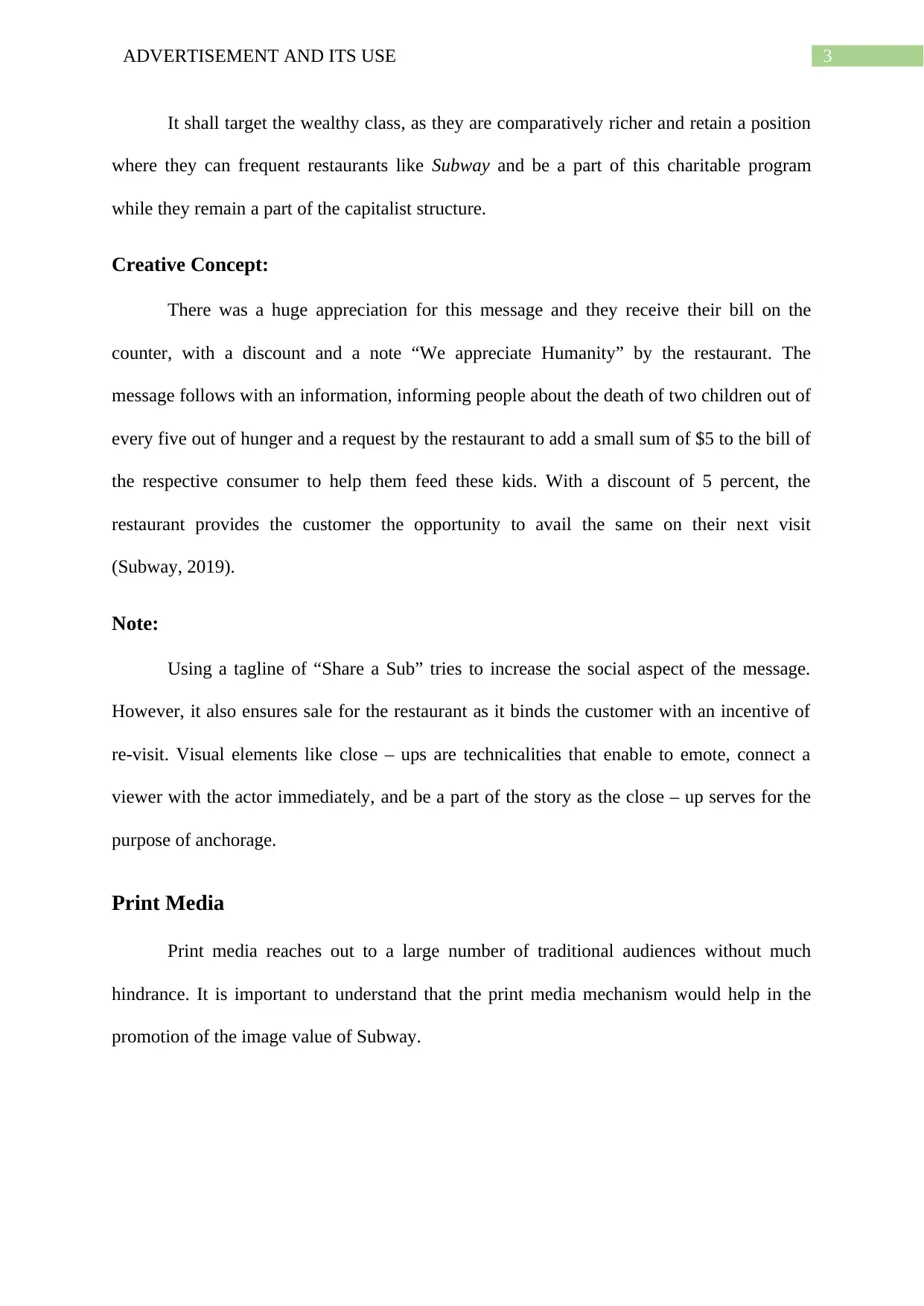
3ADVERTISEMENT AND ITS USE
It shall target the wealthy class, as they are comparatively richer and retain a position
where they can frequent restaurants like Subway and be a part of this charitable program
while they remain a part of the capitalist structure.
Creative Concept:
There was a huge appreciation for this message and they receive their bill on the
counter, with a discount and a note “We appreciate Humanity” by the restaurant. The
message follows with an information, informing people about the death of two children out of
every five out of hunger and a request by the restaurant to add a small sum of $5 to the bill of
the respective consumer to help them feed these kids. With a discount of 5 percent, the
restaurant provides the customer the opportunity to avail the same on their next visit
(Subway, 2019).
Note:
Using a tagline of “Share a Sub” tries to increase the social aspect of the message.
However, it also ensures sale for the restaurant as it binds the customer with an incentive of
re-visit. Visual elements like close – ups are technicalities that enable to emote, connect a
viewer with the actor immediately, and be a part of the story as the close – up serves for the
purpose of anchorage.
Print Media
Print media reaches out to a large number of traditional audiences without much
hindrance. It is important to understand that the print media mechanism would help in the
promotion of the image value of Subway.
It shall target the wealthy class, as they are comparatively richer and retain a position
where they can frequent restaurants like Subway and be a part of this charitable program
while they remain a part of the capitalist structure.
Creative Concept:
There was a huge appreciation for this message and they receive their bill on the
counter, with a discount and a note “We appreciate Humanity” by the restaurant. The
message follows with an information, informing people about the death of two children out of
every five out of hunger and a request by the restaurant to add a small sum of $5 to the bill of
the respective consumer to help them feed these kids. With a discount of 5 percent, the
restaurant provides the customer the opportunity to avail the same on their next visit
(Subway, 2019).
Note:
Using a tagline of “Share a Sub” tries to increase the social aspect of the message.
However, it also ensures sale for the restaurant as it binds the customer with an incentive of
re-visit. Visual elements like close – ups are technicalities that enable to emote, connect a
viewer with the actor immediately, and be a part of the story as the close – up serves for the
purpose of anchorage.
Print Media
Print media reaches out to a large number of traditional audiences without much
hindrance. It is important to understand that the print media mechanism would help in the
promotion of the image value of Subway.
Paraphrase This Document
Need a fresh take? Get an instant paraphrase of this document with our AI Paraphraser
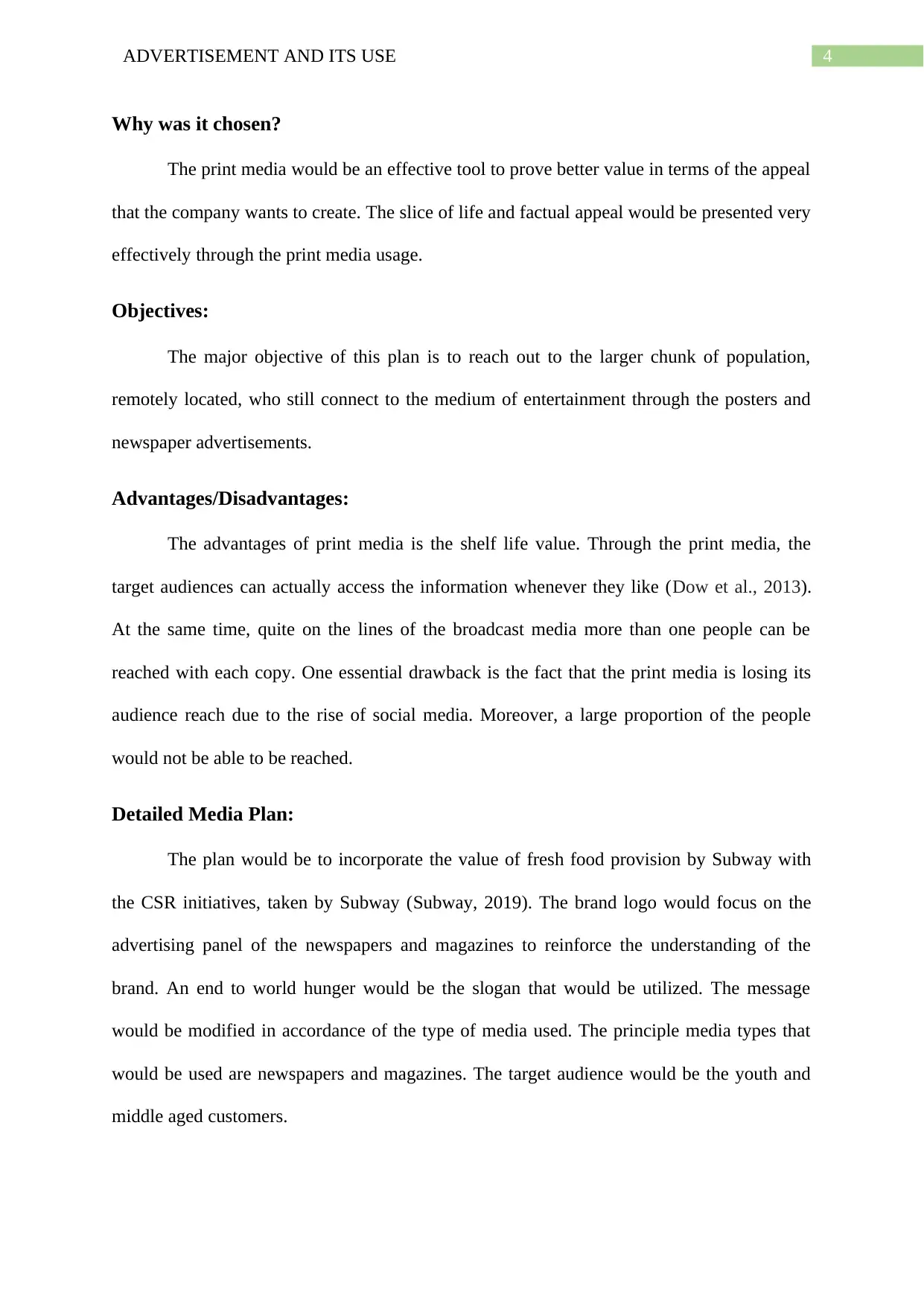
4ADVERTISEMENT AND ITS USE
Why was it chosen?
The print media would be an effective tool to prove better value in terms of the appeal
that the company wants to create. The slice of life and factual appeal would be presented very
effectively through the print media usage.
Objectives:
The major objective of this plan is to reach out to the larger chunk of population,
remotely located, who still connect to the medium of entertainment through the posters and
newspaper advertisements.
Advantages/Disadvantages:
The advantages of print media is the shelf life value. Through the print media, the
target audiences can actually access the information whenever they like (Dow et al., 2013).
At the same time, quite on the lines of the broadcast media more than one people can be
reached with each copy. One essential drawback is the fact that the print media is losing its
audience reach due to the rise of social media. Moreover, a large proportion of the people
would not be able to be reached.
Detailed Media Plan:
The plan would be to incorporate the value of fresh food provision by Subway with
the CSR initiatives, taken by Subway (Subway, 2019). The brand logo would focus on the
advertising panel of the newspapers and magazines to reinforce the understanding of the
brand. An end to world hunger would be the slogan that would be utilized. The message
would be modified in accordance of the type of media used. The principle media types that
would be used are newspapers and magazines. The target audience would be the youth and
middle aged customers.
Why was it chosen?
The print media would be an effective tool to prove better value in terms of the appeal
that the company wants to create. The slice of life and factual appeal would be presented very
effectively through the print media usage.
Objectives:
The major objective of this plan is to reach out to the larger chunk of population,
remotely located, who still connect to the medium of entertainment through the posters and
newspaper advertisements.
Advantages/Disadvantages:
The advantages of print media is the shelf life value. Through the print media, the
target audiences can actually access the information whenever they like (Dow et al., 2013).
At the same time, quite on the lines of the broadcast media more than one people can be
reached with each copy. One essential drawback is the fact that the print media is losing its
audience reach due to the rise of social media. Moreover, a large proportion of the people
would not be able to be reached.
Detailed Media Plan:
The plan would be to incorporate the value of fresh food provision by Subway with
the CSR initiatives, taken by Subway (Subway, 2019). The brand logo would focus on the
advertising panel of the newspapers and magazines to reinforce the understanding of the
brand. An end to world hunger would be the slogan that would be utilized. The message
would be modified in accordance of the type of media used. The principle media types that
would be used are newspapers and magazines. The target audience would be the youth and
middle aged customers.
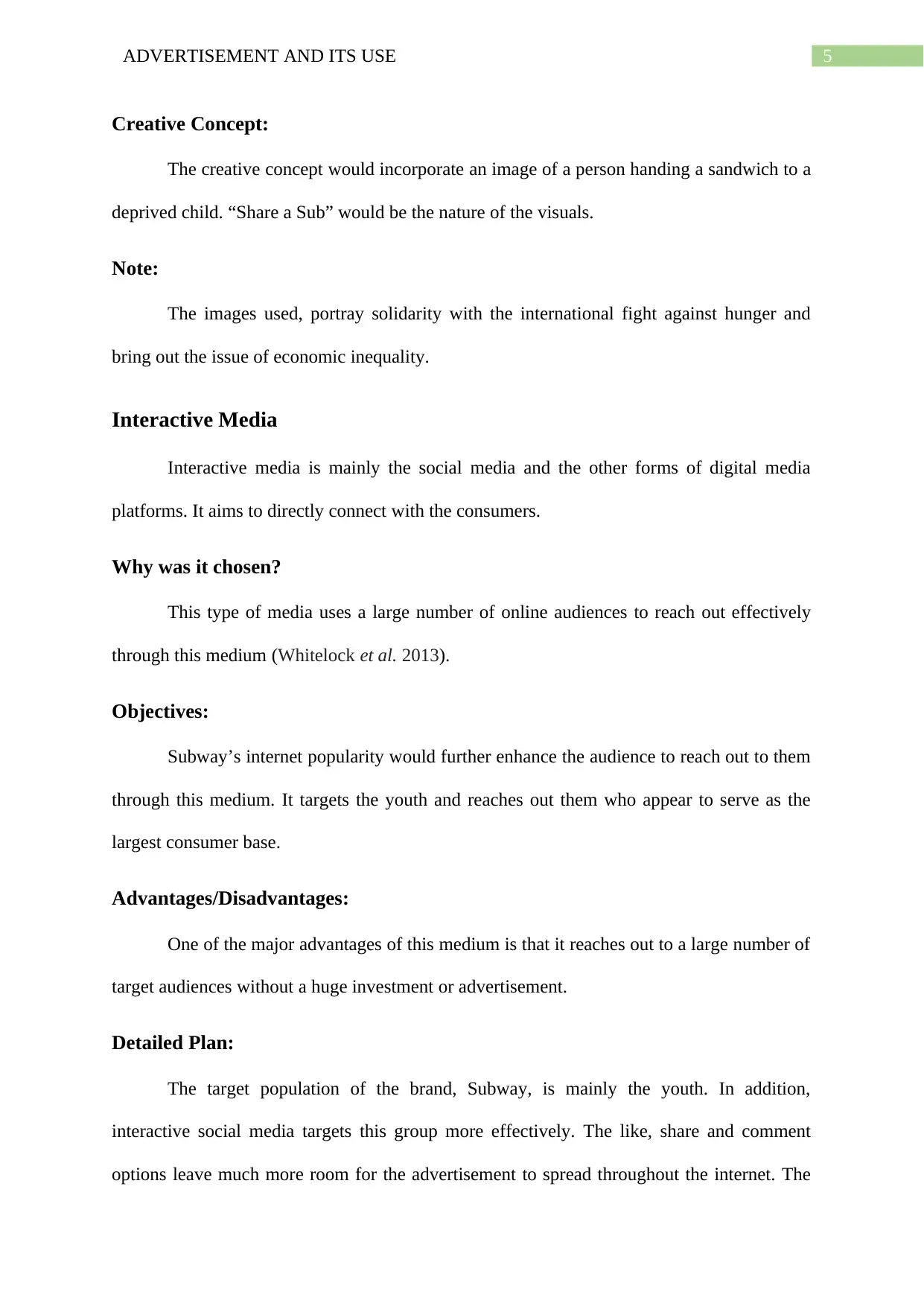
5ADVERTISEMENT AND ITS USE
Creative Concept:
The creative concept would incorporate an image of a person handing a sandwich to a
deprived child. “Share a Sub” would be the nature of the visuals.
Note:
The images used, portray solidarity with the international fight against hunger and
bring out the issue of economic inequality.
Interactive Media
Interactive media is mainly the social media and the other forms of digital media
platforms. It aims to directly connect with the consumers.
Why was it chosen?
This type of media uses a large number of online audiences to reach out effectively
through this medium (Whitelock et al. 2013).
Objectives:
Subway’s internet popularity would further enhance the audience to reach out to them
through this medium. It targets the youth and reaches out them who appear to serve as the
largest consumer base.
Advantages/Disadvantages:
One of the major advantages of this medium is that it reaches out to a large number of
target audiences without a huge investment or advertisement.
Detailed Plan:
The target population of the brand, Subway, is mainly the youth. In addition,
interactive social media targets this group more effectively. The like, share and comment
options leave much more room for the advertisement to spread throughout the internet. The
Creative Concept:
The creative concept would incorporate an image of a person handing a sandwich to a
deprived child. “Share a Sub” would be the nature of the visuals.
Note:
The images used, portray solidarity with the international fight against hunger and
bring out the issue of economic inequality.
Interactive Media
Interactive media is mainly the social media and the other forms of digital media
platforms. It aims to directly connect with the consumers.
Why was it chosen?
This type of media uses a large number of online audiences to reach out effectively
through this medium (Whitelock et al. 2013).
Objectives:
Subway’s internet popularity would further enhance the audience to reach out to them
through this medium. It targets the youth and reaches out them who appear to serve as the
largest consumer base.
Advantages/Disadvantages:
One of the major advantages of this medium is that it reaches out to a large number of
target audiences without a huge investment or advertisement.
Detailed Plan:
The target population of the brand, Subway, is mainly the youth. In addition,
interactive social media targets this group more effectively. The like, share and comment
options leave much more room for the advertisement to spread throughout the internet. The
⊘ This is a preview!⊘
Do you want full access?
Subscribe today to unlock all pages.

Trusted by 1+ million students worldwide
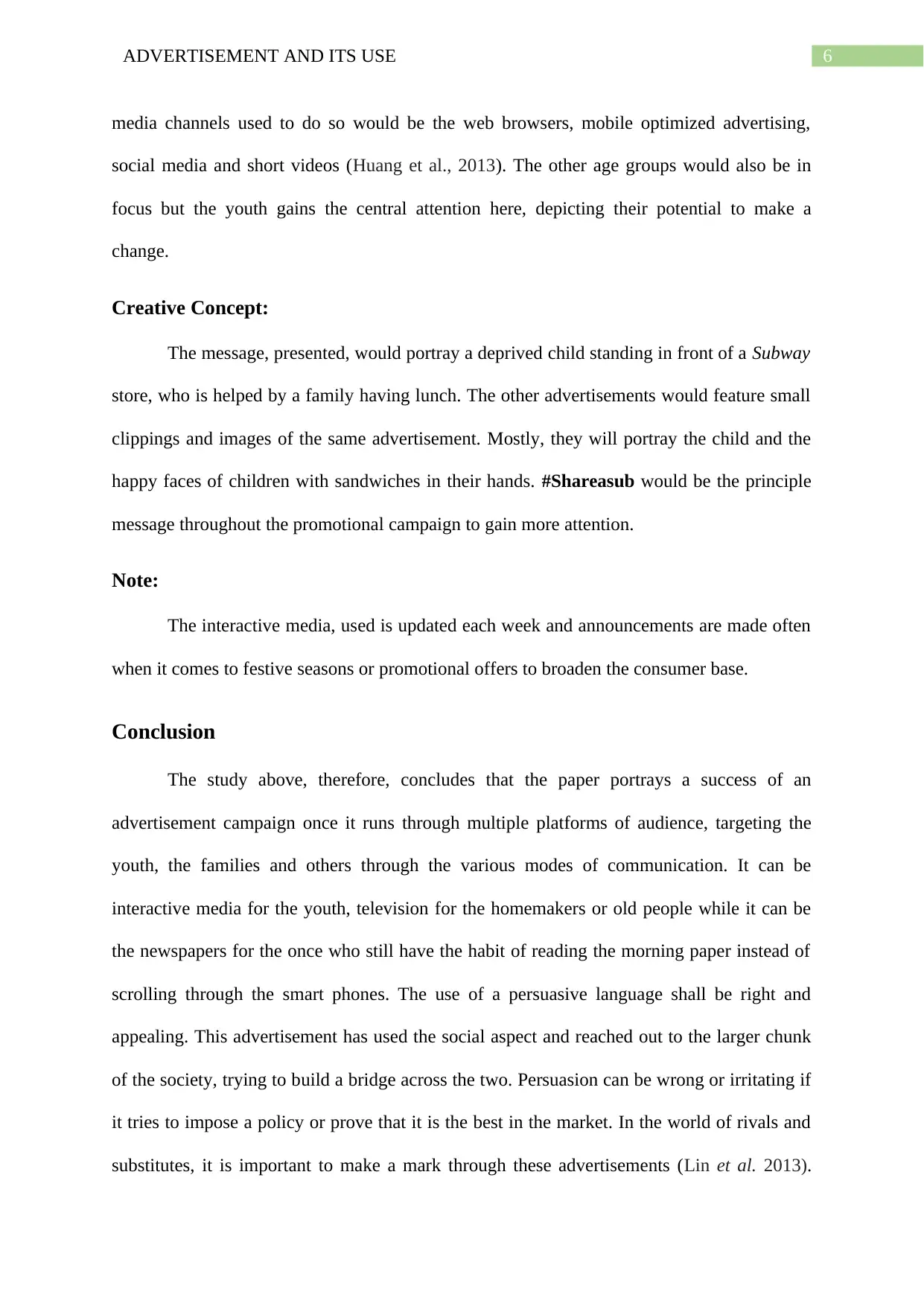
6ADVERTISEMENT AND ITS USE
media channels used to do so would be the web browsers, mobile optimized advertising,
social media and short videos (Huang et al., 2013). The other age groups would also be in
focus but the youth gains the central attention here, depicting their potential to make a
change.
Creative Concept:
The message, presented, would portray a deprived child standing in front of a Subway
store, who is helped by a family having lunch. The other advertisements would feature small
clippings and images of the same advertisement. Mostly, they will portray the child and the
happy faces of children with sandwiches in their hands. #Shareasub would be the principle
message throughout the promotional campaign to gain more attention.
Note:
The interactive media, used is updated each week and announcements are made often
when it comes to festive seasons or promotional offers to broaden the consumer base.
Conclusion
The study above, therefore, concludes that the paper portrays a success of an
advertisement campaign once it runs through multiple platforms of audience, targeting the
youth, the families and others through the various modes of communication. It can be
interactive media for the youth, television for the homemakers or old people while it can be
the newspapers for the once who still have the habit of reading the morning paper instead of
scrolling through the smart phones. The use of a persuasive language shall be right and
appealing. This advertisement has used the social aspect and reached out to the larger chunk
of the society, trying to build a bridge across the two. Persuasion can be wrong or irritating if
it tries to impose a policy or prove that it is the best in the market. In the world of rivals and
substitutes, it is important to make a mark through these advertisements (Lin et al. 2013).
media channels used to do so would be the web browsers, mobile optimized advertising,
social media and short videos (Huang et al., 2013). The other age groups would also be in
focus but the youth gains the central attention here, depicting their potential to make a
change.
Creative Concept:
The message, presented, would portray a deprived child standing in front of a Subway
store, who is helped by a family having lunch. The other advertisements would feature small
clippings and images of the same advertisement. Mostly, they will portray the child and the
happy faces of children with sandwiches in their hands. #Shareasub would be the principle
message throughout the promotional campaign to gain more attention.
Note:
The interactive media, used is updated each week and announcements are made often
when it comes to festive seasons or promotional offers to broaden the consumer base.
Conclusion
The study above, therefore, concludes that the paper portrays a success of an
advertisement campaign once it runs through multiple platforms of audience, targeting the
youth, the families and others through the various modes of communication. It can be
interactive media for the youth, television for the homemakers or old people while it can be
the newspapers for the once who still have the habit of reading the morning paper instead of
scrolling through the smart phones. The use of a persuasive language shall be right and
appealing. This advertisement has used the social aspect and reached out to the larger chunk
of the society, trying to build a bridge across the two. Persuasion can be wrong or irritating if
it tries to impose a policy or prove that it is the best in the market. In the world of rivals and
substitutes, it is important to make a mark through these advertisements (Lin et al. 2013).
Paraphrase This Document
Need a fresh take? Get an instant paraphrase of this document with our AI Paraphraser
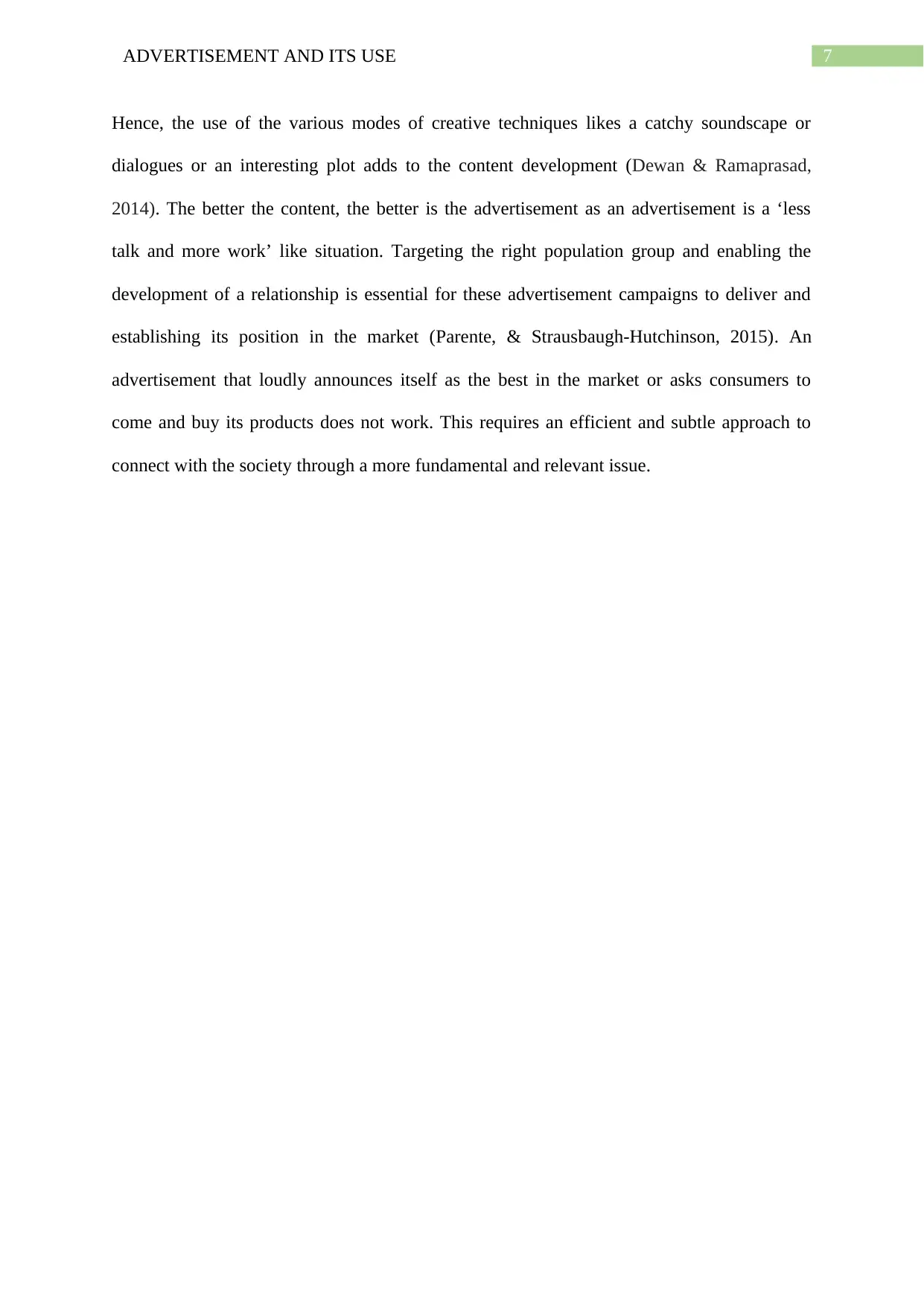
7ADVERTISEMENT AND ITS USE
Hence, the use of the various modes of creative techniques likes a catchy soundscape or
dialogues or an interesting plot adds to the content development (Dewan & Ramaprasad,
2014). The better the content, the better is the advertisement as an advertisement is a ‘less
talk and more work’ like situation. Targeting the right population group and enabling the
development of a relationship is essential for these advertisement campaigns to deliver and
establishing its position in the market (Parente, & Strausbaugh-Hutchinson, 2015). An
advertisement that loudly announces itself as the best in the market or asks consumers to
come and buy its products does not work. This requires an efficient and subtle approach to
connect with the society through a more fundamental and relevant issue.
Hence, the use of the various modes of creative techniques likes a catchy soundscape or
dialogues or an interesting plot adds to the content development (Dewan & Ramaprasad,
2014). The better the content, the better is the advertisement as an advertisement is a ‘less
talk and more work’ like situation. Targeting the right population group and enabling the
development of a relationship is essential for these advertisement campaigns to deliver and
establishing its position in the market (Parente, & Strausbaugh-Hutchinson, 2015). An
advertisement that loudly announces itself as the best in the market or asks consumers to
come and buy its products does not work. This requires an efficient and subtle approach to
connect with the society through a more fundamental and relevant issue.
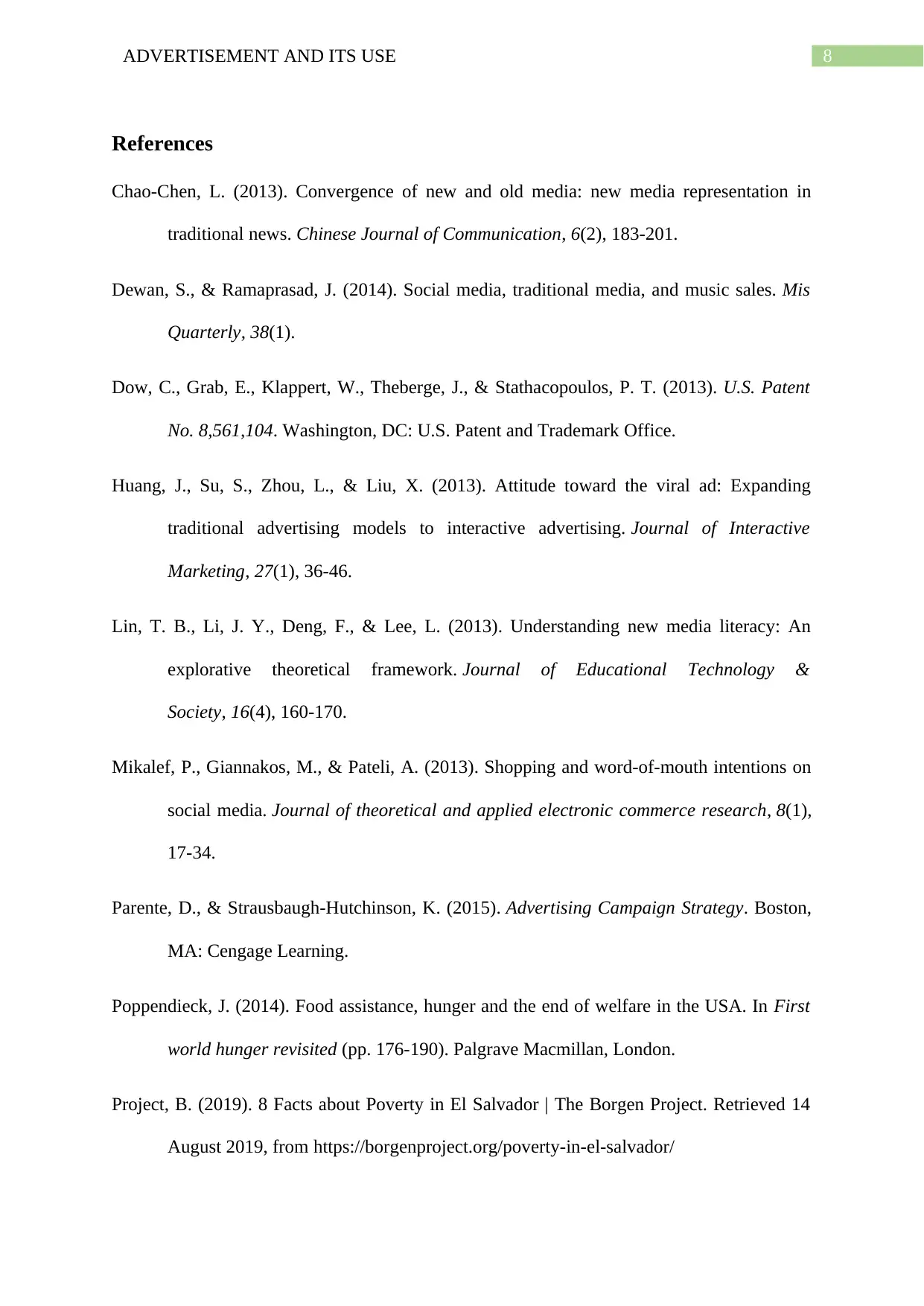
8ADVERTISEMENT AND ITS USE
References
Chao-Chen, L. (2013). Convergence of new and old media: new media representation in
traditional news. Chinese Journal of Communication, 6(2), 183-201.
Dewan, S., & Ramaprasad, J. (2014). Social media, traditional media, and music sales. Mis
Quarterly, 38(1).
Dow, C., Grab, E., Klappert, W., Theberge, J., & Stathacopoulos, P. T. (2013). U.S. Patent
No. 8,561,104. Washington, DC: U.S. Patent and Trademark Office.
Huang, J., Su, S., Zhou, L., & Liu, X. (2013). Attitude toward the viral ad: Expanding
traditional advertising models to interactive advertising. Journal of Interactive
Marketing, 27(1), 36-46.
Lin, T. B., Li, J. Y., Deng, F., & Lee, L. (2013). Understanding new media literacy: An
explorative theoretical framework. Journal of Educational Technology &
Society, 16(4), 160-170.
Mikalef, P., Giannakos, M., & Pateli, A. (2013). Shopping and word-of-mouth intentions on
social media. Journal of theoretical and applied electronic commerce research, 8(1),
17-34.
Parente, D., & Strausbaugh-Hutchinson, K. (2015). Advertising Campaign Strategy. Boston,
MA: Cengage Learning.
Poppendieck, J. (2014). Food assistance, hunger and the end of welfare in the USA. In First
world hunger revisited (pp. 176-190). Palgrave Macmillan, London.
Project, B. (2019). 8 Facts about Poverty in El Salvador | The Borgen Project. Retrieved 14
August 2019, from https://borgenproject.org/poverty-in-el-salvador/
References
Chao-Chen, L. (2013). Convergence of new and old media: new media representation in
traditional news. Chinese Journal of Communication, 6(2), 183-201.
Dewan, S., & Ramaprasad, J. (2014). Social media, traditional media, and music sales. Mis
Quarterly, 38(1).
Dow, C., Grab, E., Klappert, W., Theberge, J., & Stathacopoulos, P. T. (2013). U.S. Patent
No. 8,561,104. Washington, DC: U.S. Patent and Trademark Office.
Huang, J., Su, S., Zhou, L., & Liu, X. (2013). Attitude toward the viral ad: Expanding
traditional advertising models to interactive advertising. Journal of Interactive
Marketing, 27(1), 36-46.
Lin, T. B., Li, J. Y., Deng, F., & Lee, L. (2013). Understanding new media literacy: An
explorative theoretical framework. Journal of Educational Technology &
Society, 16(4), 160-170.
Mikalef, P., Giannakos, M., & Pateli, A. (2013). Shopping and word-of-mouth intentions on
social media. Journal of theoretical and applied electronic commerce research, 8(1),
17-34.
Parente, D., & Strausbaugh-Hutchinson, K. (2015). Advertising Campaign Strategy. Boston,
MA: Cengage Learning.
Poppendieck, J. (2014). Food assistance, hunger and the end of welfare in the USA. In First
world hunger revisited (pp. 176-190). Palgrave Macmillan, London.
Project, B. (2019). 8 Facts about Poverty in El Salvador | The Borgen Project. Retrieved 14
August 2019, from https://borgenproject.org/poverty-in-el-salvador/
⊘ This is a preview!⊘
Do you want full access?
Subscribe today to unlock all pages.

Trusted by 1+ million students worldwide
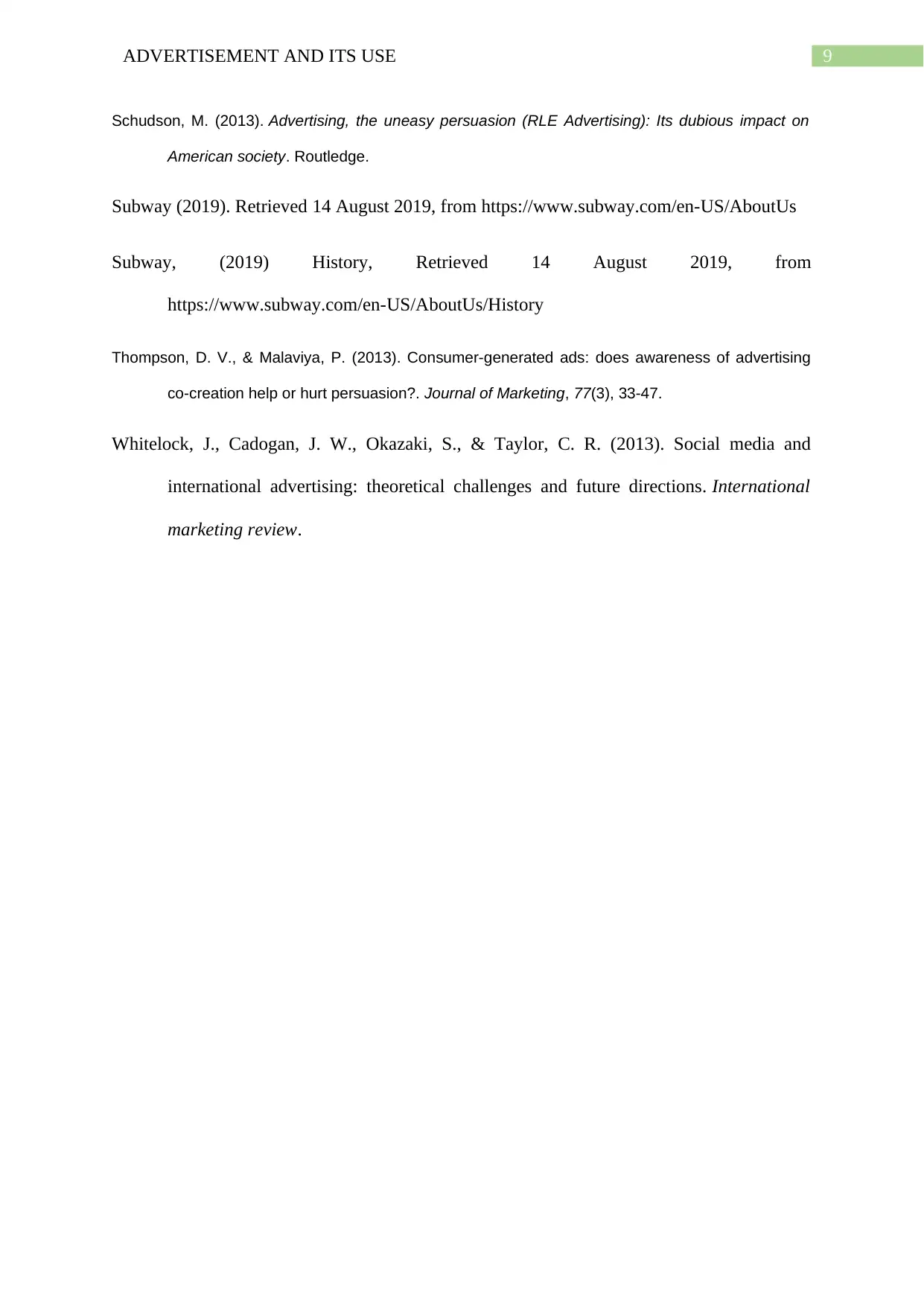
9ADVERTISEMENT AND ITS USE
Schudson, M. (2013). Advertising, the uneasy persuasion (RLE Advertising): Its dubious impact on
American society. Routledge.
Subway (2019). Retrieved 14 August 2019, from https://www.subway.com/en-US/AboutUs
Subway, (2019) History, Retrieved 14 August 2019, from
https://www.subway.com/en-US/AboutUs/History
Thompson, D. V., & Malaviya, P. (2013). Consumer-generated ads: does awareness of advertising
co-creation help or hurt persuasion?. Journal of Marketing, 77(3), 33-47.
Whitelock, J., Cadogan, J. W., Okazaki, S., & Taylor, C. R. (2013). Social media and
international advertising: theoretical challenges and future directions. International
marketing review.
Schudson, M. (2013). Advertising, the uneasy persuasion (RLE Advertising): Its dubious impact on
American society. Routledge.
Subway (2019). Retrieved 14 August 2019, from https://www.subway.com/en-US/AboutUs
Subway, (2019) History, Retrieved 14 August 2019, from
https://www.subway.com/en-US/AboutUs/History
Thompson, D. V., & Malaviya, P. (2013). Consumer-generated ads: does awareness of advertising
co-creation help or hurt persuasion?. Journal of Marketing, 77(3), 33-47.
Whitelock, J., Cadogan, J. W., Okazaki, S., & Taylor, C. R. (2013). Social media and
international advertising: theoretical challenges and future directions. International
marketing review.
1 out of 10
Related Documents
Your All-in-One AI-Powered Toolkit for Academic Success.
+13062052269
info@desklib.com
Available 24*7 on WhatsApp / Email
![[object Object]](/_next/static/media/star-bottom.7253800d.svg)
Unlock your academic potential
Copyright © 2020–2025 A2Z Services. All Rights Reserved. Developed and managed by ZUCOL.





